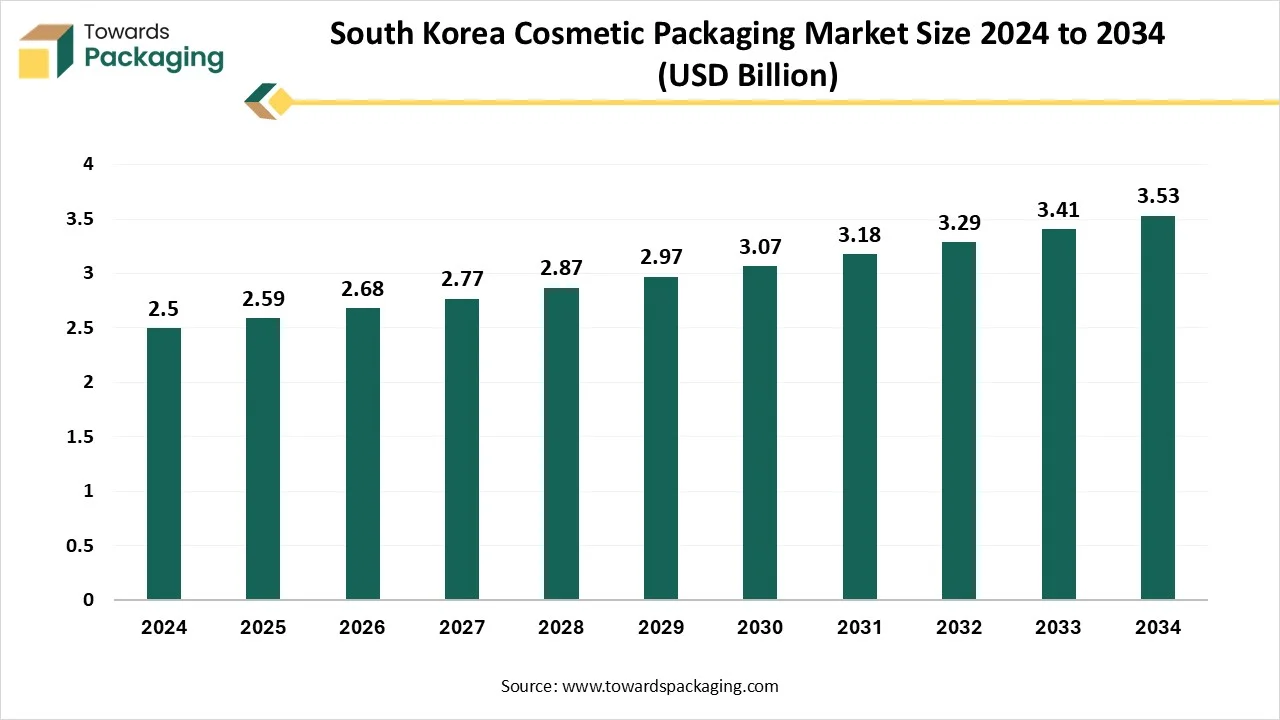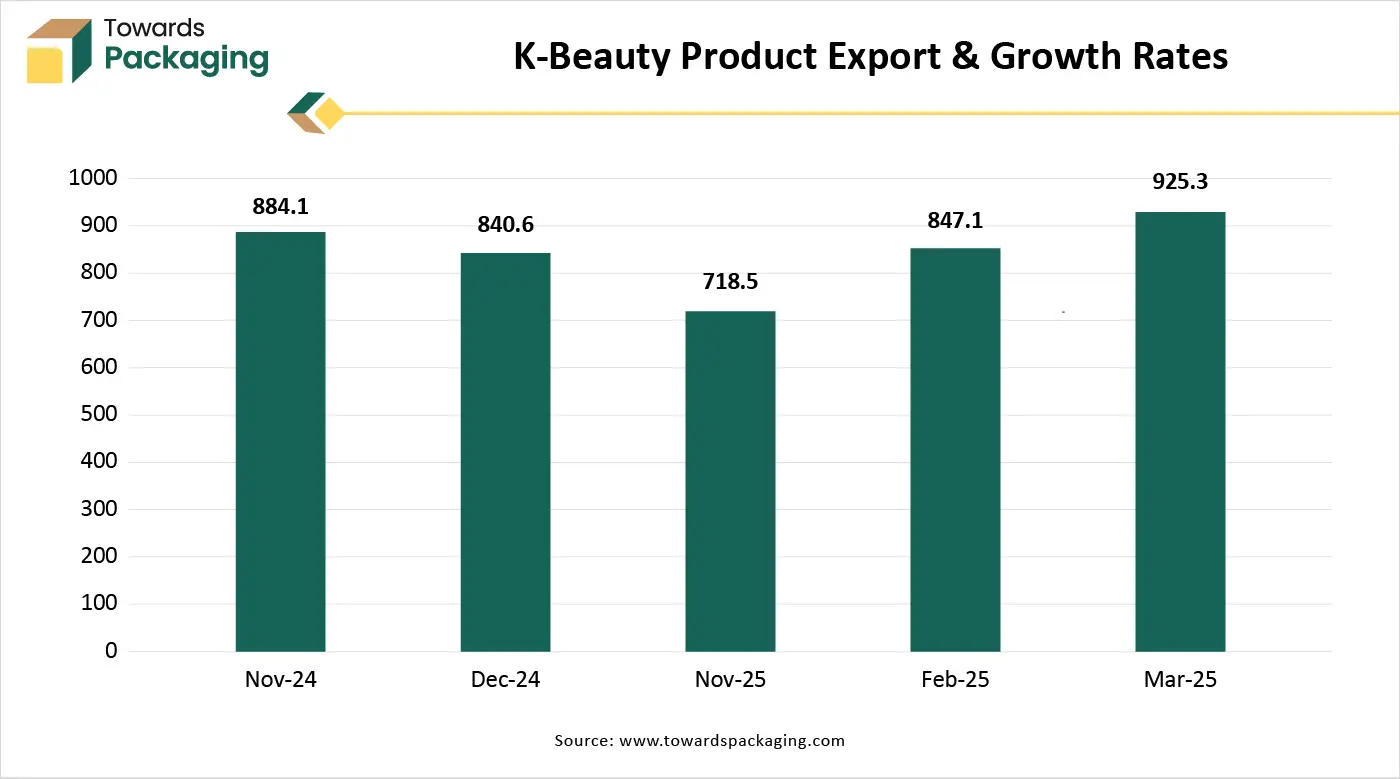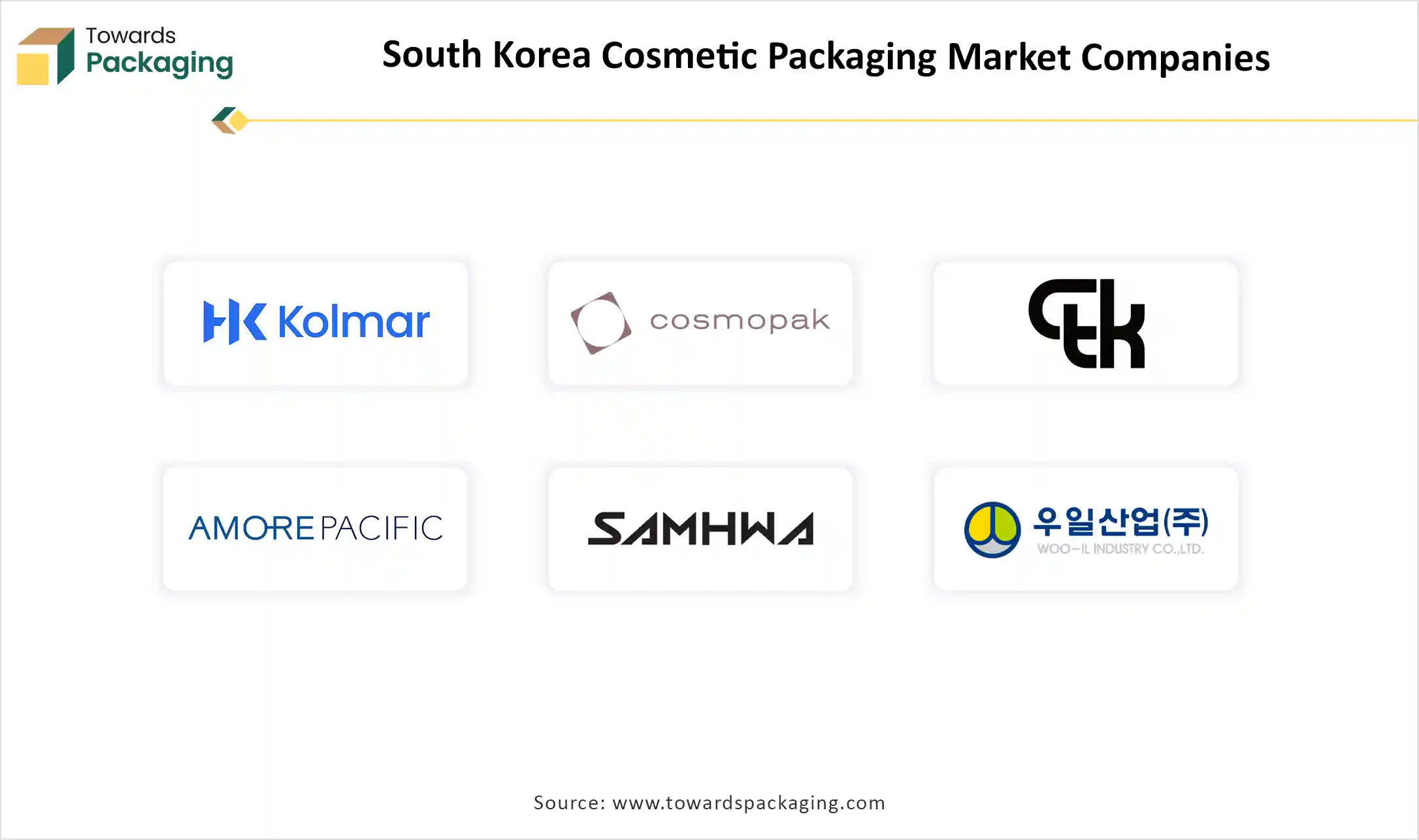December 2025
The South Korea cosmetic packaging market is valued at USD 2.59 billion in 2025 and is projected to reach USD 3.53 billion by 2034, growing at a CAGR of 3.5% during 2025–2034. This report provides full quantitative coverage of market size, historical data, and detailed forecasts by material (with plastics such as PET and PP leading in 2024 and sustainable/bio-based materials growing the fastest), by product (bottles dominating in 2024 and airless tubes expanding at the highest CAGR), by packaging functionality (primary packaging leading and refillable formats growing fastest), by technology (standard injection molding dominating and airless packaging rising most rapidly), by application (skincare leading and cosmeceuticals/dermatologicals growing the fastest), and by end-user type (mass-market brands dominating and indie & D2C brands expanding quickest).
In addition, the study benchmarks South Korea’s positioning against North America, Europe, APAC, Latin America, and the Middle East & Africa using regional demand, trade flows, and import–export statistics. The report also delivers company profiles and competitive analysis of key players such as Yonwoo, Kolmar Korea Packaging, Samhwa Plastic, Amorepacific and LG H&H packaging units, along with value chain mapping, OEM/ODM ecosystem analysis, trade data, and detailed manufacturer and supplier databases to support strategic sourcing and market entry decisions.

Cosmetic packaging refers to the containers, wrappers, and overall design used to encase and protect cosmetic products such as creams, lotions, lipsticks, perfumes, foundations, and other beauty-related items. It includes both primary packaging (directly holding the product, like bottles, jars, tubes) and secondary packaging (outer boxes or labels). Cosmetic packaging is essential not only for preserving the quality and hygiene of the product but also for attracting consumers through aesthetics, branding, and functionality. Innovative materials, eco-friendliness, ease of use, and visual appeal play key roles in cosmetic packaging design and production.
A rising preference for sustainable and recyclable packaging is encouraging manufacturers to adopt eco-friendly materials like biodegradable plastics, glass, and refillable containers. Companies are also focusing on compact, travel-friendly packaging designs to align with consumer convenience. Additionally, the popularity of e-commerce is influencing the development of tamper-proof, lightweight, and protective packaging suitable for long-distance delivery. The market benefits from strong domestic R&D capabilities, government support for sustainability, and an agile manufacturing sector that quickly adapts to global packaging trends and consumer demands.
AI integration can significantly enhance the South Korea cosmetic packaging industry by streamlining production, improving design, and personalizing consumer experiences. In manufacturing, AI-driven automation enables faster, more precise packaging processes, reducing waste and ensuring consistent quality. Machine learning algorithms can analyze consumer behaviour and trends to help brands create packaging that aligns with market preferences, such as preferred colors, materials, or formats. AI also assists in product customization by allowing real-time design adjustments and on-demand printing, which is especially valuable in South Korea’s trend-sensitive beauty market.
In logistics and quality control, AI-enabled systems detect defects and optimize inventory management, ensuring timely distribution with minimal errors. For sustainability, AI tools can simulate the environmental impact of different packaging materials, guiding brands toward greener alternatives. Furthermore, AI enhances e-commerce packaging by predicting shipping stresses and suggesting more protective yet efficient designs. Smart packaging solutions using AI, such as QR codes linked to virtual skincare guides or product authentication, create interactive consumer experiences, building brand trust and engagement.
Increased Global Popularity of K-Beauty
The export of K-beauty products to international markets necessitates attractive, durable, and compliant packaging, driving innovation and growth in the packaging sector. South Korea is a global leader in beauty innovations, particularly in skincare, which fuels continuous demand for high-quality, functional, and visually appealing cosmetic packaging. Growing environmental consciousness among consumers is pushing brands to adopt eco-friendly, biodegradable, and recyclable packaging, opening new opportunities for material innovation.
South Korean consumers prioritize product appearance and packaging as a reflection of quality and brand value. This emphasis on visual appeal propels investment in creative and premium packaging designs. The rise of online beauty retail increases the demand for protective, lightweight, and tamper-proof packaging suited for long-distance delivery. The market for K-beauty is expanding rapidly on a global scale due to increasing interest in its distinctive skincare concepts and cutting-edge products. Brands like Anua, Biodance, and Skin1004 are becoming more popular in this “second wave” of K-beauty, which is characterized by an emphasis on natural ingredients, multi-step procedures, and distinctive formulations.

Strict Environmental Regulations & Supply Chain Disruptions
While sustainability is a driver, evolving government regulations around plastic usage, recyclability, and waste management can pose compliance challenges and require significant investment in R&D and infrastructure. Fluctuations in the availability and prices of raw materials, such as bioplastics or glass, can disrupt manufacturing timelines and impact profit margins, especially during global crises. Not all cosmetic brands, especially domestic startups and SMEs, are fully aware or capable of implementing advanced packaging technologies or sustainable practices. The cosmetic packaging sector is highly competitive with both local and international players. This leads to pricing pressure and limits profit margins, particularly for generic or non-branded packaging manufacturers.
Plastic remains the dominant material type segment in the South Korea cosmetic packaging market due to its cost-effectiveness, versatility, and adaptability to consumer and brand needs. It is more affordable than alternatives like glass or metal, making it ideal for large-scale production across both premium and mass-market cosmetics. Its flexibility allows manufacturers to mold it into a wide range of shapes and designs, such as pumps, tubes, jars, and compacts formats that are highly preferred in the Korean beauty sector. Plastic is also lightweight and durable, reducing shipping costs and making it more convenient for e-commerce packaging, which is rapidly growing in South Korea.
Several types of plastics offer excellent barrier properties, helping protect cosmetic products from moisture, UV light, and contamination, thereby extending product shelf life. Plastic packaging is compatible with advanced features such as airless dispensers and tamper-evident designs, which enhance functionality and appeal. Moreover, ongoing innovations in recyclable and bio-based plastics are helping the industry meet sustainability goals without compromising on performance, ensuring plastic retains its dominant position despite rising environmental concerns.
The sustainable or bio-based materials segment is emerging as the fastest-growing segment in the South Korea cosmetic packaging market due to increasing consumer awareness of environmental issues and the demand for eco-friendly alternatives. South Korean consumers, particularly younger demographics, are placing greater importance on sustainability, prompting brands to adopt biodegradable, recyclable, or compostable packaging made from materials like sugarcane, cornstarch, bamboo, and paper. Additionally, government regulations and policies aimed at reducing plastic waste are encouraging companies to shift toward greener packaging solutions.
The global image of South Korea as a leader in innovation and ethical consumerism also drives cosmetic brands to showcase their commitment to environmental responsibility through sustainable packaging choices. Technological advancements in material science have made bio-based packaging more functional, aesthetically pleasing, and compatible with product safety standards. Furthermore, the rise in premium and niche beauty brands that emphasize clean and green branding has further boosted demand for sustainable materials. As environmental consciousness continues to shape purchasing behaviour, the sustainable and bio-based materials segment is set to experience accelerated growth in South Korea's dynamic cosmetic packaging landscape.
Bottles dominate the South Korea cosmetic packaging market because they are highly versatile, accommodating liquid and semi-liquid products like toners, serums, cleansers, and lotions. Their varied materials, plastic, glass, or aluminum, offer barrier protection, durability, and visual appeal, aligning with both functional and premium branding needs. Bottles also support innovative features such as airless pumps, dropper caps, and refill systems, enhancing user convenience and hygiene. Moreover, their compatibility with e-commerce, being lightweight, leak-resistant, and travel-friendly, makes them the preferred choice for both manufacturers and consumers.
The airless tube segment is the fastest-growing in the South Korea cosmetic packaging market due to its superior ability to preserve the integrity of sensitive skincare formulations. These tubes prevent air exposure, which protects products from oxidation and contamination, extending shelf life, an essential feature for natural and high-performance cosmetics. South Korea’s advanced skincare industry favours airless packaging for serums, creams, and lotions that require precision and hygiene. Consumers also appreciate the controlled dispensing and minimal product waste. With the rise of clean beauty and preservative-free formulas, demand for airless tubes continues to surge among both brands and consumers.
The primary segment dominates the South Korea cosmetic packaging market due to its direct role in preserving product integrity, hygiene, and usability. It includes containers like bottles, jars, tubes, and pumps that hold the actual cosmetic product, making it essential for protecting against contamination and extending shelf life. South Korean consumers highly value clean, functional, and aesthetically pleasing packaging, making primary packaging a critical branding tool. Additionally, innovations like airless pumps and sustainable materials are being integrated into primary packaging, further enhancing its market dominance.
The refillable segment is rapidly gaining traction in South Korea’s cosmetic packaging market due to growing consumer demand for sustainability and waste reduction. By enabling consumers to reuse durable outer containers such as glass jars, metal compacts, or high-quality plastic bottles, refillable systems significantly reduce single-use packaging waste. South Korean brands are responding with sleek, modular designs that make refilling both convenient and aesthetically appealing, reinforcing brand loyalty. Governments and retailers are also promoting refill stations and eco-friendly initiatives, boosting adoption. Additionally, refillable packaging often offers cost savings over time, making it attractive to both eco-conscious and budget-savvy consumers.
The skincare segment is the dominant segment in the South Korea cosmetic packaging market due to the country’s strong cultural emphasis on skincare as part of daily self-care routines. South Korea is globally recognized for its advanced skincare industry, which includes products like cleansers, toners, essences, serums, moisturizers, and sunscreens. These products require diverse and specialized packaging formats such as pumps, airless tubes, droppers, and jars that protect sensitive formulations and enhance user convenience. Additionally, consumers’ preference for multi-step skincare regimens leads to higher product volumes and increased packaging demand. Continuous product innovation and premium branding further support the dominance of skincare packaging in the market.
The cosmeceuticals or dermatological segment is the fastest-growing application segment in the South Korea cosmetic packaging market due to rising consumer interest in science-backed, functional skincare products. As more people seek treatments for issues like acne, aging, sensitivity, and pigmentation, demand for dermatologist-formulated products with active ingredients has surged. These formulations often require advanced, protective packaging such as airless pumps, opaque containers, and tamper-proof seals to preserve efficacy and hygiene.
Additionally, South Korea's emphasis on innovation and clinical skincare trends drives continuous product development, further boosting packaging needs. The segment also benefits from increased trust in medical-grade beauty products and a growing health-conscious consumer base.
The standard injection segment dominates the South Korea cosmetic packaging market due to its precision, efficiency, and ability to produce complex, high-quality packaging components. This technology is widely used to manufacture plastic containers, caps, and closures that meet the demands of South Korea’s innovative and visually driven cosmetic industry. It allows for mass production with consistent shapes and intricate details, which is ideal for the country’s diverse range of skincare and makeup products. Additionally, injection molding supports customization, rapid prototyping, and compatibility with sustainable materials, making it a preferred choice for brands focused on both functionality and design excellence.
The airless segment is rapidly outperforming others in South Korea’s cosmetic packaging market due to its effective protection of sensitive skincare formulations from oxidation and contamination. By preventing air exposure, airless systems such as pumps, bottles, and tubes help maintain product efficacy and extend shelf life, which is vital for high-performance serums, creams, and dermatological treatments. The trend is supported by sustainability mandates encouraging refillable and recyclable airless solutions, along with consumer preferences for hygienic, portable, and elegant packaging. Additionally, South Korea’s booming pharmaceutical and K-beauty industries are driving demand for precision-dispensing and sterile packaging formats, further fueling growth.
The mass-market brand segment dominates South Korea’s cosmetic packaging landscape due to its extensive reach, affordable price points, and high-volume sales. Over 50% of the beauty market is made up of mass brands, driven by accessible distribution channels such as Olive Young and online platforms, which prioritize practical yet visually appealing packaging. These brands demand cost-effective packaging solutions like plastic bottles and tubes that deliver on functionality and branding without high production costs. Their fast product turnover, propelled by trend-driven consumer behaviour and influencer marketing, further reinforces the need for scalable packaging. Consequently, mass-market brands remain the dominant end‑user segment in South Korea’s cosmetic packaging market.
The indie and D2C brand segment is the fastest-growing end-user type in South Korea’s cosmetic packaging market due to several intertwined factors. First, a surge of small, agile indie brands, nearly 28,000 registered in 2024, up from 15,700 in 2019, is fueling demand. Backed by a robust OEM/ODM infrastructure, these brands can rapidly bring to market innovative formulations and packaging with minimal upfront investment.
Additionally, indie labels strongly emphasize unique storytelling, eco-conscious values, and social‑media‑friendly design. Custom molds, playful visuals, and sustainable materials help them go viral. This approach, combining speed, creativity, personalization, and green messaging, resonates deeply with Gen Z and millennial consumers seeking novel experiences, positioning indie and D2C brands as the fastest-growing and most dynamic segment in cosmetic packaging.
The South Korea cosmetic packaging market is witnessing significant growth driven by the country’s dynamic beauty and skincare industry, which is globally renowned for innovation and quality. The demand for attractive, functional, and sustainable packaging solutions is on the rise as South Korean consumers place high value on aesthetics, hygiene, and environmental consciousness. Technological advancements in packaging materials and smart packaging features are further enhancing product appeal and shelf life. The growing popularity of K-beauty globally has also led to increased exports, driving the need for durable and visually compelling packaging.

By Material Type
By Product Type
By Application
By Packaging Functionality
By Packaging Technology
By End-User Type
December 2025
December 2025
November 2025
November 2025